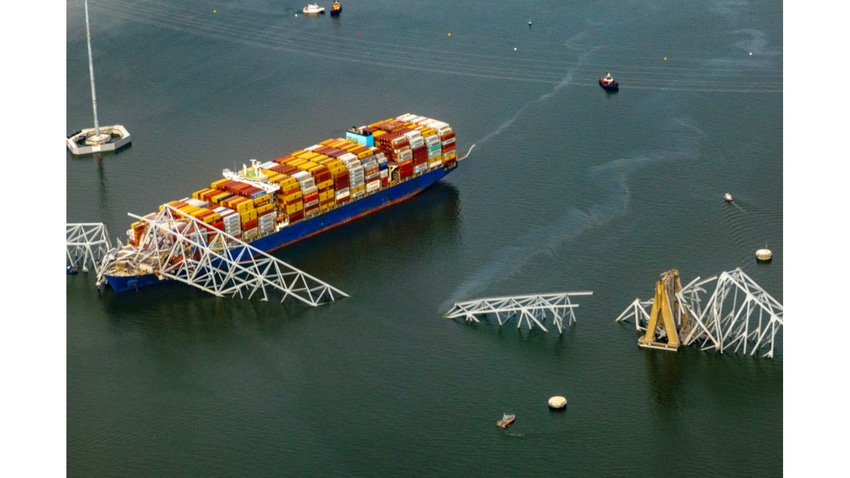Bridges and Cargo Ships Don’t Mix
The collapse of Baltimore’s Key Bridge early Tuesday morning was not the first time a bridge fell after being hit by a ship.

At a Glance
- Francis Scott Key Bridge in Baltimore collapsed after being struck by a massive cargo ship named the DALI early Tuesday.
- Six workers doing bridge work are missing and presumed dead due to the frigid waters they fell into.
- The DALI was experiencing propulsion problems and lost power, losing it ability to steer its way to safety.
Around 1:30 am Tuesday, March 26th, a 985 foot long container vessel with Singapore flags called the DALI struck one of the pillars of the Francis Scott Key Bridge in Baltimore, causing the 1.6 mile bridge to quickly collapse into frigid water. Although it was the wee hours of the morning and traffic was light, eight workers on the bridge filling potholes on the bridge’s surface fell into the frigid waters of the Patapsco River. Two people were rescued, with one person in serious condition. The other six remain missing and are unlikely to survive the chilly river.
Not surprisingly, conspiracy theories surfaced hours after the tragedy, but these were quickly dispelled as reports show the massive container ship veered off course in the Patapsco River before hitting one of the bridge’s footings head-on. The bridge has reportedly been inspected regularly, but it was not built to withstand a head-on impact from a cargo ship weighing tens of thousands of tons.
Unfortunately, this is not the first time a bridge has collapsed due to a blow from a ship. This Washington Post story recaps several instances of ships hitting bridges. Here are three of the recent incidents:
· May 26, 2002: I-40 bridge
A towboat pushing two empty barges was heading north near Webbers Falls, Okla., when it veered off course and rammed a pier. The impact collapsed a 503-foot section of the bridge, which fell into the river and onto the barges below, according to an NTSB incident report.
Eight passenger vehicles and three trucks fell into the void created by the bridge collapse, resulting in 14 deaths and five injuries.
· Sept. 15, 2001: Queen Isabella Causeway
In Port Isabel, Tex., runaway barges crashed into the Queen Isabella Causeway in the early morning darkness when a tugboat lost control of them. Two support pilings were knocked out, causing a section of the bridge to tumble into the water, according to the Federal Highway Administration. Eight people died when motorists, unwarned and unable to see the chasm created by the collapse, drove off the gap.
· April 4, 1998: Eads Bridge
A tow boat traveling through the St. Louis harbor hit the center span of the Eads Bridge. Eight barges broke away, three of which crashed into a gambling vessel that was moored there. Fifty people suffered minor injuries, according to the NTSB.
Bridges Cannot Survive Such Impacts
There have been bridge incidents over the years where the design and structure of the bridge has been called into question. For instance, the Point Pleasant Bridge in West Virginia, known as the Silver Bridge, collapsed over the Ohio River in 1967, killing 46 people with the failure of an eyebar chain cited as the culprit. The collapse led to federal regulations on inspecting bridges and an increased emphasis on bridge safety through the Federal-Aid Highway Act of 1968, which established a National Bridge Inspection Program.
But more robust bridge construction does not include protecting the bridge’s supports from a massive, heavy container ship hitting it. According to a YouTube video from Baltimore TV station WRAL, the DALI’s propulsion system failed and the ship’s lights flickered. The ship’s crew did manage to issue a May Day call to authorities, which were able to stop vehicles from entering the bridge and avoid further fatalities.
Quoting a construction expert, the video said that while bridges are designed to absorb or deflect impacts, they do not include impacts from a massive cargo ship that weighs almost as much as the bridge.
Another construction expert with railway industry experience and bridge knowledge, Dallas Richards, added, “Typically bridges of that size on that kind of shipping lane have navigational lighting to direct ships and what we call 'fender systems' which act like bumpers. But they are not designed for such a direct blow, certainly not from a ship that size.”
Ship Propulsion Failure
Given the likely exorbitant cost and difficulty with buttressing an existing bridge against such impacts from large ships, attention now turns to the ship’s systems.
In another video from the site What Is Going On With Shipping titled , the narrator, a shipping expert, noted that the ship was moving at 8 knots, which is about 9 mph, when it lost power. This in turn caused the ship to lose its ability to maneuver into the correct area to go underneath the bridge. Even though the ship dropped its anchor, it no longer had the power to steer its way out of trouble and thus could not avoid hitting the bridge head-on.
This may not be the first time the Dali has had issues. According to one report, an inspection of the Dali last June at a port in Chile identified a problem with the ship’s “propulsion and auxiliary machinery,” according to Equasis, a shipping information system. Questions now arise as to whether those problems were resolved.
The comments below the video on the shipping channel revealed more eye-raising information. One comment quoted a Baltimore port worker stating that the Dali ship experienced total power failures in the two days it was docked before the crash. “It was having power problems with draining electrical popping circuit breakers and everything with the mechanics that were working on it,” said Julie Mitchell, Co-Administrator from Container Royal which monitors the tonnage on all containers that come in and out of Baltimore Port.
Another comment noted that ships must have stand-by generators available in the event of a power failure. However, problems such as switchboard failures or auto control issues can also force the ship’s main engine to go offline, which would make it impossible to steer the massive ship out of trouble.
About the Author(s)
You May Also Like





